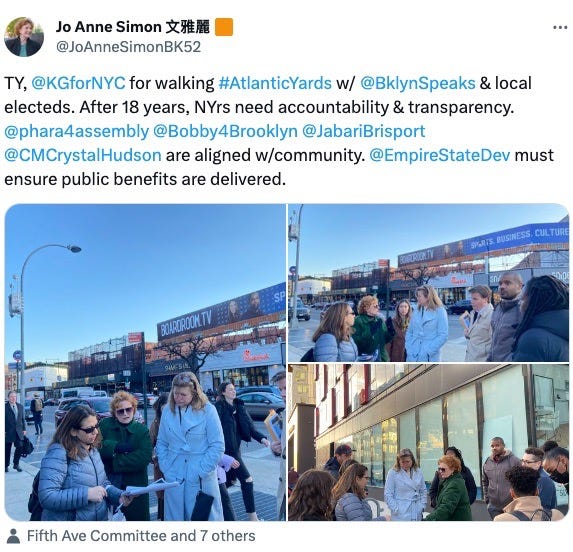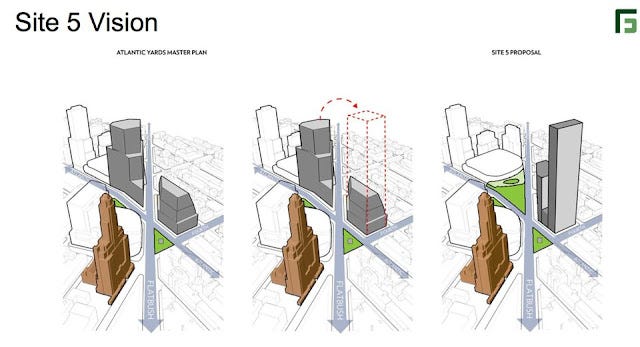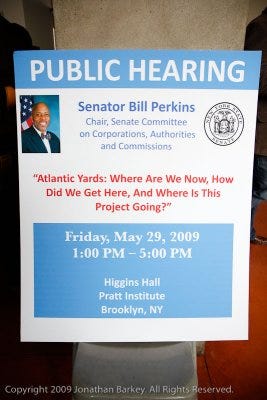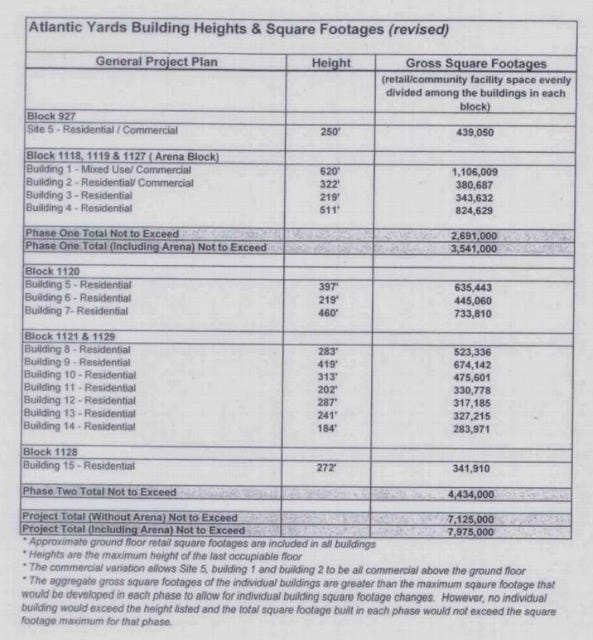Does Atlantic Yards Need a Plan? Or a Process?
Two advocates from BrooklynSpeaks propose a new LDC and federal help for affordable housing. Maybe caution is in order.
Brooklyn’s stalled Atlantic Yards needs a plan, two leaders of the BrooklynSpeaks coalition—which has pursued project improvements and accountability—argued in a Dec. 29 New York Daily News essay.
My take: it needs more than a plan, however loosely described.
It needs a process, with less certainty and more public scrutiny, because some of the authors’ proposals, notably a federal bailout for the affordable housing and a new Local Development Corporation to manage the project, deserve deeper discussion.
So does much more regarding Atlantic Yards/Pacific Park.
Before any new plan, why not some oversight hearings, as I wrote? After all, the state’s loose leash on Atlantic Yards—and, beyond that, the apparent willingness to waive contract terms—has been fundamental to the project’s struggles.
An immediate question
Before all that, we need more transparency regarding the looming Jan. 11 foreclosure auction of developer Greenland USA’s interest in the six development sites (B5-B10) over the Metropolitan Transportation Authority’s (MTA) Vanderbilt Yard.
Those sites, offered as collateral for an unpaid loan of more than $300 million $286 million from immigrant investors under the EB-5 program, can’t be built on until a costly two-block platform is constructed over the railyard, and until Greenland finishes paying the MTA for development rights.
(It’s paid for the first three sites, by my calculation, though it hasn’t taken possession; that process isn’t simple.)
Is New York State willing to revise project obligations, notably a May 2025 deadline, which comes with significant liquidated damages, to deliver 876 more units of affordable housing ?
If not, why would anyone bid?
No clue from the Governor
It’s stunning that the only thing we’ve gotten out of New York State officials is boilerplate:
Governor [Kathy] Hochul’s highest priority is expanding New York’s housing supply and promoting housing growth, and Empire State Development is focused on the successful buildout and completion of this project. We are currently reviewing the situation and are working to determine the best path forward.
Hochul, by the way, will deliver her State of the State address tomorrow.
The only advocates?
Because the essay's authors in 2014 negotiated (in part) and endorsed the previous revised Atlantic Yards plan--notably, a new 2025 deadline for affordable housing--and claimed they'd achieved accountability, they deserve skepticism too, since that achievement also had significant flaws they papered over.
One author is Michelle de la Uz, is executive director of the Fifth Avenue Committee, which develops affordable housing, among other things. The other, Gib Veconi, is identified as chair of the Prospect Heights Neighborhood Development Council, which advocates for neighborhood issues.
He’s also a key member of Community Board 8’s Land Use Committee—which has endorsed spot rezonings of projects involving the Fifth Avenue Committee—and a key member of the Atlantic Yards Community Development Corporation (AY CDC), the advisory body set up after that 2014 renegotiation.
They're the most active leaders of BrooklynSpeaks, the “mend-it-don’t-end-it” coalition that has become the main forum to channel public interest in Atlantic Yards, especially since project opposition Develop Don’t Destroy Brooklyn faded.
Looking to the future
In early 2022, BrooklynSpeaks sponsored four charettes about the future of Atlantic Yards/Pacific Park, under the banner Crossroads. That was a worthy effort. However, those sessions also seemed designed to refine and ratify the group’s already-stated principles.
(Most of those principles are defensible, but they also might be used to justify any increase in bulk if it delivers more affordable housing.)
So they have the ear of the few elected officials, such as Assemblymember Jo Anne Simon, concerned with the project, and the capacity to gain buy-in, as in 2014, from some other neighborhood and civic organizations for a quietly negotiated deal.

The screenshot above shows Simon, with leaders of BrooklynSpeaks like de la Uz, walking around the project site March 12, 2022 with key gubernatorial aide Kathryn Garcia, Director of State Operations.
Her local elected official colleagues, wrote Simon, “are aligned with community.” However, as discussed further below, it’s not simple to define the community.
“A full accounting”?
When news of the foreclosure surfaced in late November, BrooklynSpeaks, in a press release, recommended city and state investigations.
“The public deserves a full accounting of how things have gone so wrong at Atlantic Yards,” de la Uz stated. (Note: the original press release, for whatever reason, is no longer available on the BrooklynSpeaks site.)
After all, the questions asked before a 2009 state legislative hearing persist: “Atlantic Yards: Where Are We Now, How Did We Get Here, And Where Is This Project Going?”
Blame the lack of an LDC?
In their Daily News essay, the authors fault the structure of government oversight:
Unlike other plans overseen by Empire State Development [ESD], that state agency never established a dedicated local development corporation [LDC] with resources necessary to manage a $6 billion project. Instead, it trusted a single developer, Forest City Ratner Companies, to plan and build all sixteen buildings and an arena.
That may be part of it, but, as I wrote, perhaps the project was fundamentally flawed from the start.
Veconi and de la Uz suggest that a new LDC might fix things, but I'm not sure that Battery Park City and Queens West are sufficient parallels. Yes, in those cases the "state formed local development corporations that bid out sites to multiple developers to manage risk," but they also involved publicly owned land.
And Ron Shiffman, the veteran advocacy planner and Pratt Institute academic, last year observed that all governance models, including the Harlem Urban Development Corporation, have their flaws.
Moreover, it's not just an issue of structure. It's also the underlying contract, and the state’s deferential posture.
The Development Agreement for Atlantic Yards allows for much flexibility: extensions of deadlines for "Unavoidable Delay," as well as the "right to refrain" from enforcement.
Moreover, history shows that, as ESD has the dual--and potentially contradictory--role of overseeing the project while shepherding it, it has generally favored the latter.
What next?
The future for now is a black box. Would a new LDC help the state manage Atlantic Yards, as developed by a new majority owner of Greenland USA’s development rights?
Would Greenland retain some ownership stake. given that it has already made partial payment to the Metropolitan Transportation Authority to unlock development at those parcels?
If no one bids, does Greenland get an extension? What role would public ownership play? What about the development of Site 5, the parcel catercorner to the arena (as discussed below)?
Affordable housing fines?
de la Uz and Veconi write that Hochul’s administration should make clear that damages for failing to complete promised affordable housing will be collected.
That's a significant pivot point.
The $2,000/month penalties for each of 876 (or 877) units not delivered by May 2025 would be a significant sum, and surely would affect the foreclosure sale. So that deserves transparency too.
Even former Deputy Mayor Alicia Glen believes the penalties should stand, as well. But history shows the state has been unwilling to pressure the developer
If that's still the case--and the state is considering waiving those damages, or extend the deadline--then what would the public get in return? If not, is the state willing to take over the project?
Accountability and affordability
While the authors suggest an Atlantic Yards Local Development Corporation with a "board that includes local elected officials and community members" could "ensure transparent and accountable decision-making," that's hardly certain.
It might be an improvement, but keep in mind that the authors, representing BrooklynSpeaks, already claimed success with accountability.
In BrooklynSpeaks' press release announcing the 2014 agreement, de la Uz said, "We’re pleased that our tireless efforts to ensure public accountability have paid off, and that we were able to come to an agreement with Forest City and the State to ensure the community finally gets the affordable housing it was promised 10 years ago."
That wasn't true. The below-market units delivered after that announcement were skewed toward middle-income households, with income over 100% of Area Median Income (AMI), and the four most recent towers—thanks to the state’s revised 421-a tax break—contain, among “affordable” units, only middle-income ones.
According to the 2005 Affordable Housing Memorandum of Understanding (MOU) that Forest City signed with the advocacy group ACORN, 900 of 2,250 below-market units, or 40%, were for middle-income households.
So far, the project has delivered 1,054 middle-income units out of 1,374 total, or nearly 77%. Moreover, the rising AMI—more than double that projected in 2005—means that low-income households may no longer even qualify.
de la Uz has said BrooklynSpeaks didn't have control over the affordability; if so, she shouldn't have made that claim.
Accountability and oversight
As to the Atlantic Yards Community Development Corporation (AY CDC), that was less than the more robust entity BrooklynSpeaks sought in 2014.
Still, after the first--and delayed--meeting of the AY CDC, in February 2015, BrooklynSpeaks stated, conclusorily, "we are confident they will... work together to harness diverse perspectives into solutions."
I was more skeptical at the time. By December 2021, I assessed the AY CDC's record as troubling, noting the state's unwillingness to provide information and set a regular schedule, as well as the underwhelming performance of many board members.
I'd acknowledge that Veconi, a later addition to the AY CDC board, is one of the few who’s come prepared to meetings and has pursued accountability.
Notably, he proposed a resolution, which passed unanimously in August, that the state, by October, provide an assessment of the project’s financial viability. That didn’t happen.
Nor did Shiffman, another recent addition to the board, get a response to his request that ESD report on how the affordable housing delivered compares to that promised. (My chart above does answer that question, but it’s unofficial.)
ESD performance
From the op-ed:
Although dense residential construction over a rail yard had never been proven economical outside of Manhattan, ESD never independently verified the project’s viability.
Yes, and no. As I wrote, Empire State Development conducted its own analysis of project benefits, based on an optimistic analysis of project progress, rather than a wider range of probabilities.
It later hired the consulting firm KPMG, twice, to produce documents--flawed at the time and even more so in retrospect--that declared the project was viable.
From the op-ed:
Moreover, it agreed to defer construction of the platform and its buildings until the last phase of development. When FCRC ran into financial headwinds in 2009, ESD agreed to extend that last phase by another 15 years
Keep in mind that, in 2011, BrooklynSpeaks endorsed "pragmatic changes" in the project, including "Build first on currently developable parcels, deferring the costly Vanderbilt Yards platform." That recognized the challenge, but didn’t question the fundamental plan.
ESD deference
ESD has been consistently willing to defer to the developer's requests, even if it did, according to former Project Director Arana Hankin, periodically push back.
In a September 2013 lecture, Hankin, once liberated by a Loeb Fellowship at Harvard, observed, “There really is no accountability,” after saying public agencies like ESD fail to assess whether estimated jobs actually arrived, though its mission is to promote economic growth.
Project agreements, she lamented, were “purposely drafted to be as complicated and obtuse as possible, to allow for multiple interpretations and maximum flexibility." One of her roles was to determine "how ESD should respond to developer requests for additional benefits, and there were many."
Hankin’s lecture has never been discussed at any AY CDC (or ESD) meeting. It’s a good bet most of the purported project advisors don’t know about it.
What next?
Write the authors:
Gov. Hochul should direct ESD to independently study the economic feasibility of building over the rail yard, something the agency has never done.
That’s worth doing, but a deeper dive—into both the flawed history of the project as well as potential paths forward for the entire project, including Site 5, open space, and perhaps even another school—is also worthwhile.
What level of government support might be necessary to make the project viable and, if so, where the money would come from? What might the public get in response?
They add:
She should then work with Democratic congressional leaders to fund any gap necessary for the remaining affordable housing to reach low-income Brooklyn residents.
I'm not sure Democratic congressional leaders could bail out the project until and unless the Democrats control the House of Representatives, which might happen by 2025.
And should they? While federal money might be an option, shouldn’t the costs and trade-offs be assessed?
Affordable housing faster?
The authors conclude:
Even if Hochul does all of these things, it will still be many years until housing appears above the Vanderbilt rail yard. That’s why her administration must also identify sites near the project and fund deeply affordable housing to be developed now to meet an urgent local need.
That's interesting.
That suggests that, as the City Council proceeds to approve the pending Atlantic Avenue Mixed-Use Plan (AAMUP), which includes proposals for less affordable housing than has been achieved in some private rezonings in the area just east of the Atlantic Yards/Pacific Park site, the state should step in to ensure more.
(Veconi and de la Uz were part of the AAMUP Steering Committee.)
Does that mean publicly owned sites, where the base land cost is lower? (There aren’t many.) Does it mean extra subsidies for specific privately owned parcels?
Unmentioned: Site 5
The longer the wait for affordable housing, the more expensive it gets, as Area Median Income (AMI)—the base for calculating affordability—rises, at least without more subsidies.
Does that justify, for example, a larger project at Site 5, the parcel catercorner to the arena across Flatbush Avenue, long approved for a substantial, 250-foot, 440,000-square foot tower?
That’s the last remaining Atlantic Yards/Pacific Park site outside of the foreclosure sale.

The developer has since 2016 floated plans to move the bulk of the unbuilt flagship tower (aka Miss Brooklyn), once slated to loom over the arena, to Site 5, creating a two-tower project nearly 800 feet and containing more than 1.1 million square feet.
That could be enormously valuable, unlocking a site worth, by my loose estimate, $300 million.
That could also leave perhaps 400,000 square feet not transferred. That could--with state approval--be redistributed to the six railyard sites, B5-B10, which are already approved for large towers, totally nearly 3.5 million square feet.
Should such transfers be supported if they deliver more affordable housing and/or help cross-subsidize the platform? Or is that not the only consideration?
Unresolved at Crossroads: how big?
BrooklynSpeaks’ 2022 Crossroads series was spurred not by the future of the six railyard sites, but the expected effort by Greenland to active the bulk transfer.
One question unresolved: how big should Site 5 be?
After all, the larger the project, the easier it is for the developer to make concessions in terms of affordability and public space, though at the cost of imposing on the site's nearest neighbors, including a loading dock on what BrooklynSpeaks has proposed as a "slow street."
As I wrote, the Crossroads sessions barely discussed whether the developer's request for the bulk transfer should be embraced as long as it delivers more deeply affordable housing?
(Keep in mind that, at least as of 2006, the City Planning Commission called for the Site 5 building to be scaled down to 250 feet, as part of a “transition.”)
Assessing Site 5: an FAR of 23.5?
A common way to assess density is Floor Area Ratio, or FAR, the multiple of bulk to the underlying lot. Downtown Brooklyn in 2004 was rezoned to an FAR of 10, with an opportunity for bonuses to reach an FAR of 12.
In New York City, residential (but not commercial) floor area is currently capped at 12. Gov. Hochul has proposed removing that cap.
The project at Site 5, as proposed in 2016, would have a FAR of 23.5, nearly twice the allowable bulk and some 50% bulkier than the already anomalously large 80 Flatbush project, now known as The Alloy Block, a few blocks northwest.
That could be enormously valuable to the developer—and, yes, spin off more affordable housing as a fraction of the total.
Is that justified?
Note that de la Uz’s Fifth Avenue Committee partnered with the developer of 80 Flatbush, essentially arguing that more affordability—plus two new schools—justified the increase in scale.
She claimed the benefits were being created “without any public subsidy.” Sure, no direct cash. But upzoning is very valuable.
Complicated questions
The issues are complicated, as discussed at one Crossroads session.
“So that really speaks to the trade-off: Can they go up 80 stories if they give us another acre of parkland, another school?” asked Regina Cahill of the North Flatbush Business Improvement District, one of the presenters.
Reporting back from a breakout group, Cahill said the central message was “Don't give the developer any more until they meet the commitments they've already made.”
“And then also who is the community and who gets to decide what… the trade-offs will be, if you're going to do trade-offs,” she said. “And I think that's a big question.”
That question might be addressed by transparency, oversight, and process--before any definitive plan.
Going forward
At the end of the Crossroads sessions in early 2022, Veconi said BrooklynSpeaks would take in the comments made and “come back with a kind of synthesis.”
Nothing emerged, so I followed up in January 2023.
"Following the Crossroads workshops, we have discussed the input we received with the developer, the State and elected officials," Veconi responded. "We are currently soliciting additional third-party input, with the goal of producing a more detailed vision of challenges and opportunities at the site."
That hasn’t happened yet, but it’s a reasonable goal, even if the challenges today are different. In other words, process ahead of plan, especially since, as Shiffman suggested, more stakeholders should be involved.
A 2018 process proposal
Back in 2018, when the Site 5 plan seemed to have momentum, board member Jaime Stein of the Atlantic Yards Community Development Corporation suggested promoting more public discussion and engagement.
Her recommendations, shared with community organizations and governmental bodies, argued that the "complexity and longevity of the AY Project requires an additional, independent process."
Stein wanted the AY CDC to serve more as an advocate for the public interest, not a prop for the parent Empire State Development.
When the Site 5 proposal was released, she suggested, the AY CDC Board and ESD should hire third-party planning, design and construction consultants to review the proposal to inform the board and the public.
Those consultants would convene and facilitate at least two preliminary public meetings and then share community priority issues with the board.
Too much process?
The likely response--as we heard when Stein raised the issue at an AY CDC meeting--is that this is time-consuming and duplicates the current environmental review process (which is already seen by some as burdensome).
And that might be the same response to any proposed changes in Atlantic Yards/Pacific Park.
But that assumes that AKRF, the state's ubiquitous environmental consultant, is hired to protect the public interest rather than to ensure that a project—and any new plan—passes legal muster.
So that brings us back to a fundamental issue: how could a credible resolution to the complicated Atlantic Yards challenges be found until the past, and the performance of government, is understood more clearly and critically?








